Step-index Fibers
Definition: optical fibers with a step-index refractive index profile
More general term: optical fibers
German: Stufenindexfasern
Category: fiber optics and waveguides
How to cite the article; suggest additional literature
Author: Dr. Rüdiger Paschotta
Optical fibers can have different refractive index profiles. Apart from such fibers where light is guided at the air–glass interface, the simplest index profile is a rectangular one, where the refractive index is constant within the fiber core, and is higher than in the cladding. Fibers of that kind are called step-index fibers. That term also includes design with multiple index steps – for example, with additional rings of increased or depressed index.

The assumption of a simple step-index profile (with a single step) is often used for calculations in fiber optics, even though standard fabrication techniques for single-mode fibers often lead to significant deviations from this simple situation. (For multimode fibers, the step-index approximation is often rather accurate.) In particular, preferential evaporation of the dopant during the collapse of the preform (assuming that the preform is made with chemical vapor deposition) often leads to a pronounced dip of the refractive index profile at the center. For profiles deviating from a step-index profile, an effective step-index profile may be defined which leads to similar mode properties as the actual profile.
The propagation modes of step-index fibers can be described with functions belonging to the family of Bessel functions, multiplied by an exponential phase factor exp(i β z) for the longitudinal phase variation. Concerning the radial dependence, the field strength in the core is proportional to the zero-order Bessel function of the first kind, and the cladding part is given by a modified Bessel function of the second kind. The mode function and its first derivative are always continuous at the core–cladding interface.
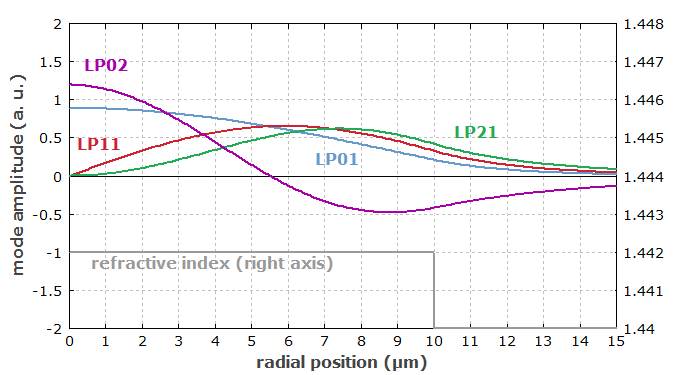
Various fiber parameters, in particular the numerical aperture and the V number, are originally defined only for step-index fibers, even though effective values are sometimes used for other fiber types. For large V values, the number of modes is proportional to V2.
Deviations for Real Fibers
Deviations from a step-index profile can result from certain techniques of fiber fabrication. For example, the index step can be somewhat smooth – more precisely described with a supergaussian function. Single-mode fibers frequently exhibit a pronounced refractive index dip at the center. In some cases, deviations from a step-index profile are intentionally used in order to achieve certain guiding properties. For example, a region with depressed refractive index between core and cladding can introduce an additional cut-off wavelength, above which the propagation losses become very high.
Numerical Problems with Step-index Profiles
Although the step-index profile is mathematically very simple, it can be somewhat problematic in numerical simulations of beam propagation. Much lower numerical errors may be achieved e.g. by replacing a step-index profile with a supergaussian profile of high order, looking quite similar to the ideal rectangular profile. The index transition should be smoothed just such that it is sampled with a few numerical grid points. In that way, one may accurately simulate a fiber with nearly the same mode structure is a true step-index fiber. Anyway, real fibers usually also exhibit some smoothing of the core–cladding interface, caused by diffusion in the fiber drawing process before the fiber is cooled down.
Questions and Comments from Users
Here you can submit questions and comments. As far as they get accepted by the author, they will appear above this paragraph together with the author’s answer. The author will decide on acceptance based on certain criteria. Essentially, the issue must be of sufficiently broad interest.
Please do not enter personal data here; we would otherwise delete it soon. (See also our privacy declaration.) If you wish to receive personal feedback or consultancy from the author, please contact him e.g. via e-mail.
By submitting the information, you give your consent to the potential publication of your inputs on our website according to our rules. (If you later retract your consent, we will delete those inputs.) As your inputs are first reviewed by the author, they may be published with some delay.
See also: fibers, single-mode fibers, multimode fibers, numerical aperture, V number, cut-off wavelength
and other articles in the category fiber optics and waveguides

This encyclopedia is authored by Dr. Rüdiger Paschotta, the founder and executive of RP Photonics Consulting GmbH. How about a tailored training course from this distinguished expert at your location? Contact RP Photonics to find out how his technical consulting services (e.g. product designs, problem solving, independent evaluations, training) and software could become very valuable for your business!
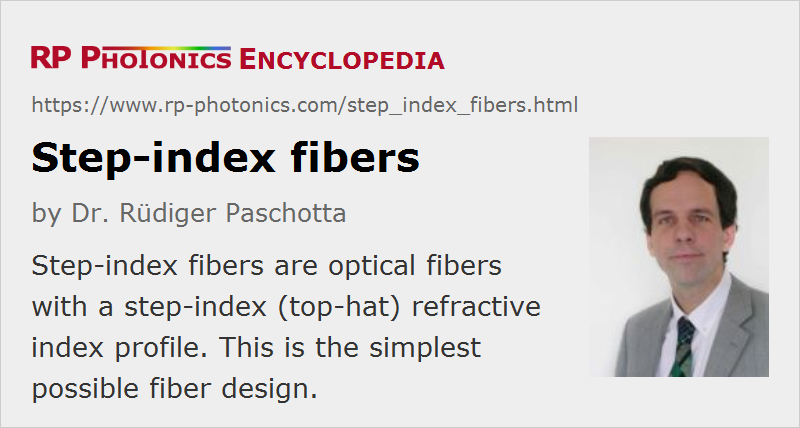 |






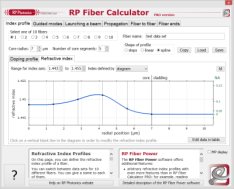
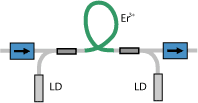

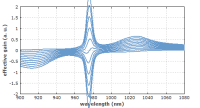
If you like this page, please share the link with your friends and colleagues, e.g. via social media:
These sharing buttons are implemented in a privacy-friendly way!